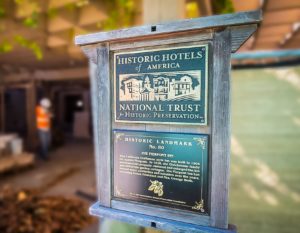Looking for Access?
Cur nutrix cantare?Est camerarius accentor, cesaris.Eposs sunt solems de varius liberi.
Register TodayCur nutrix cantare?Est camerarius accentor, cesaris.Eposs sunt solems de varius liberi.
Register TodayCur nutrix cantare?Est camerarius accentor, cesaris.Eposs sunt solems de varius liberi.
Login NowSome believe The Pierpont Inn in Ventura, California, is haunted by a former owner or another spirit. That was hardly a concern for James Elson, owner of Allguard Termite & Pest Control based in Ventura. Elson’s focus was on the living — drywood and subterranean termite infestations; the local chamber of commerce; and a huge, century-old grapevine.
The termite problem was uncovered during a cosmetic renovation being done under the watchful eye of the city’s architectural committee. Located on a scenic overlook, the inn was created to serve people driving the Pacific Coast Highway. The 115-year-old inn was state of the art for its time, with rooms that were electrified, heated and had private baths. Located just 60 miles north of Los Angeles, it was to become a favorite getaway for celebrities that included Bing Crosby, Bob Hope, Frank Sinatra and others. 
Called in to do an inspection, Allguard discovered drywood and subterranean termites throughout the structure, with the heaviest infestations in the main building. Having been expanded over the decades, the inn is now a complex that includes three guest wings, a meeting hall, a dining room, a restaurant and an outdoor pool. Its structural foundations vary from studs resting near ground level to standard concrete slabs beneath the newer additions.
The first order of business was to have the renovation crew stop its work until after a fumigation could be completed. Multiple meetings were needed with all stakeholders, including representatives of the chamber of commerce, general contractors, on-site inn managers and corporate-level management. Once the technical capabilities, insurance and financial solvency boxes for Allguard had all been checked, meetings shifted to planning the fumigation plus subterranean termite control work.
“It was early October and we needed to move quickly because the owners wanted to avoid disrupting the busy November and December holiday season,” Elson says. “We identified a one-week window in early November when we could schedule a fumigation. One unattached wing of the inn was not to be fumigated at the time, so all guests could be moved there temporarily while the fumigation was done.”
Weather in the fall is unpredictable along the Pacific Coast, which can pose a problem for scheduling a fumigation, especially when timing must be limited. Then there also was that extraordinary grapevine.
“This was no ordinary grapevine,” Elson says. “It had a trunk at the base that is at least three feet in diameter, and some of its main branches were a foot thick. This inn has a 30-by-60-foot patio formed by the building on three sides, and this grapevine’s branches — supported by timbers — basically shades the entire patio area. The city was obviously concerned that the grapevine not be harmed since it had been planted about the same time the hotel was built.”
Allguard contracted with Quality Pest Services to handle the fumigation. Larry Perez and Ed Rabago, with Quality Pest Services, met multiple times with the city to ensure that a fumigation could be done without impacting the structure. Meetings with the chef and food caterers were held regarding preparation and off-site food storage and with the facility manager to make sure guest rooms were properly prepared. Three specific meetings were held to talk about the grapevine.
Because the beams supporting the grapevine were attached in places to the structure, the fumigation plan was to exclude the vine by pulling the branches back where needed, which in some areas were as close as one or two feet from the roofline. The roof itself was old cedar shake, with fragile accent lights that had been there for perhaps 20 years. Maintenance removed the lightbulbs, and carpet padding was used to protect the brittle and fragile lighting housings.
A team of 22 crew members began the process of the fumigation. Sand snakes were laid out around the building and the ground was cleared of debris to ensure a good seal to hold the fumigant. Tarps were spread out over the roof and dropped to the eaves of the patio, so smaller tarps could be added to get behind the grapevines. Tarps were then secured from the ground up to the patio that was to be excluded from the rafters. When the crew was finished sealing the job to assure no fumigant would leak, it was time to calculate how much fumigant was to be released. The chloropicrin warning agent was released 10 minutes prior at shooting sites inside the hotel. The fumigant was then released, and the crew walked around to ensure everything was efficient. An RDA monitoring device was set up prior to the fumigation, so progress could be measured by remote location hourly to ensure no problems.
The fumigation took place in early November 2019. Quality Pest Services monitored the job, and while the plan called for an 18-hour exposure, they held it for 22 hours to further ensure efficacy on a job where there was no room for error.
Elson says timbers supporting the grapevine arbor were infested with termites and fungus, and it is being carefully replaced as part of the renovation. The end result was that the historic inn was not damaged, the job was completed on time and all the drywood termites were evicted as planned.
“This was definitely a challenging project,” Elson says. “We were dealing with a historic structure, timing for a fumigation was limited, and we had been experiencing high winds and rain. Fortunately, we had pretty decent weather when the fumigation took place.”
And as for that friendly spirit that supposedly haunts the inn, it hopefully approves of all the preservation efforts.
Click on the image below to watch the video.

To document this historic project, Allguard called in local photographer Jeffery Dawson to record the pest management work to preserve this historic landmark in California. To view more images of the fumigation, visit https://jefferydawson.photoshelter.com/index, open galleries and the folder for Pierpont Inn.